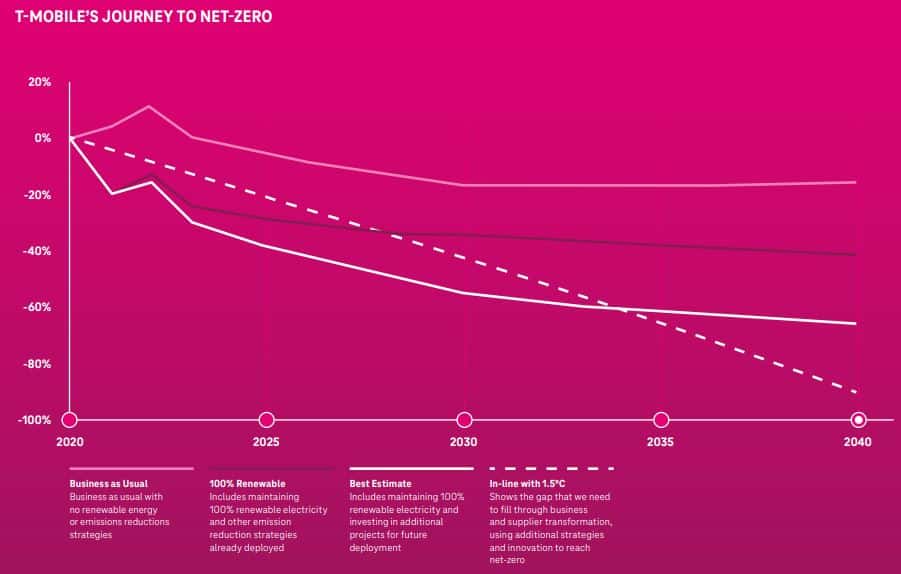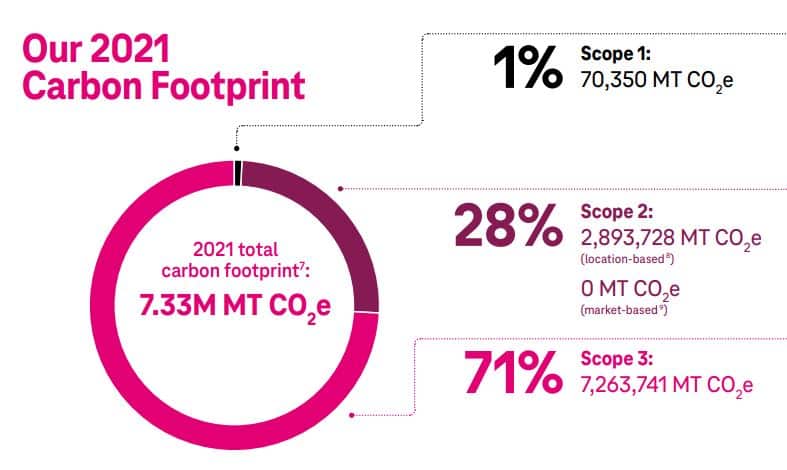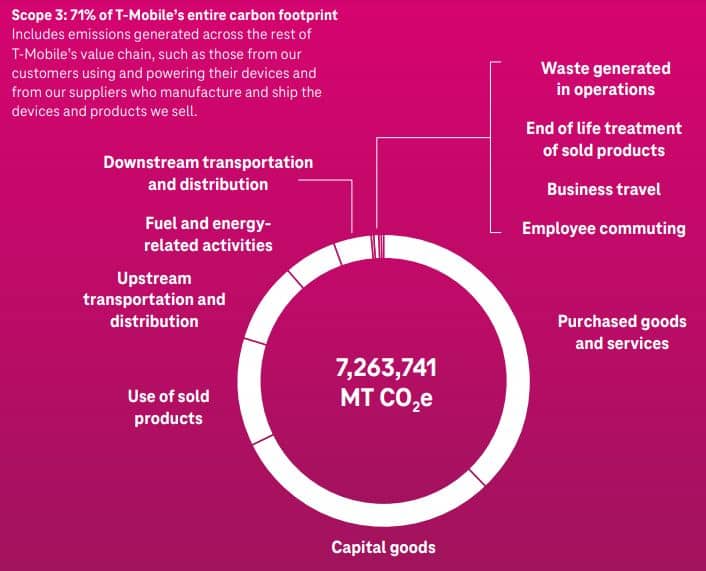T-Mobile revealed its net zero emissions target across all Scopes – 1, 2, and 3 – with the Science Based Targets initiative’s (SBTi) approval.
T-Mobile’s net zero pledge is the first among US wireless providers with SBTi validation. The company’s CEO Mike Sievert commented:
“As we know sustainability is important to our customers and stakeholders, T-Mobile has made great progress in reducing our environmental footprint – and now we’re taking even bigger steps to reduce our carbon emissions with a commitment to meet SBTi’s Net-Zero Standard .”
With a science-based approach, America’s supercharged Un-carrier aims to achieve two major targets.
- Near-term target: cut absolute Scope 1, 2, and 3 GHG emissions 55% by 2030.
- Long-term target: achieve net zero emissions across all scopes by reducing absolute emissions 90% by 2040.
T-Mobile Joins The Climate Pledge
As part of its net zero commitment, the 5G provider also said that it now becomes one of the 400+ members of The Climate Pledge. Co-founded by Amazon and Global Optimism in 2019, the Pledge is a collective commitment to reach net zero 10 years ahead of the Paris climate goal.
By joining the pact, T-Mobile and other members agree to do these climate actions:
- Measure and report GHG emissions regularly;
- Implement net zero strategies in line with the Paris Agreement through real business changes and innovations
- Offsets any remaining emissions with additional, quantifiable, real, permanent, and socially beneficial carbon offset credits.
Global Lead of The Climate Pledge at Amazon said that they’re “thrilled to see the comprehensive and thoughtful pathway they [T-Mobile] have charted to achieve net zero carbon by 2040”.
Here’s how the path of T-Mobile to 2040 net zero looks like in four scenarios.

Peter Osvaldik, the company’s CFO stated in T-Mobile’s net zero pathway report:
“T-Mobile has led the wireless industry with our commitment to sustainably managing our environmental footprint, and now we’re continuing to raise the bar with this ambitious net-zero emissions goal. Big, bold programs like this will not only have tremendously important positive outcomes on climate–they are also good business.”
Strategies to Curb Carbon Footprint
In 2021, powering its 5G network emits the bulk of T-Mobile’s operational footprint (Scopes 1 & 2).
- 5G has the potential to be the most sustainable generation of wireless networks because it uses less energy per data transmitted and supports more devices. But it needs more energy for infrastructure equipment.

The telecom provider reduces emissions by focusing first on decreasing energy use and investing in energy efficient technologies. The company employs high-efficiency rectifiers, antennas, lighting controls, and cabinet designs. They can improve cellular equipment performance and boost energy efficiency, too.
T-Mobile is further cutting its network energy demands with these measures:
- Decommissioning tens of thousands of macro cell sites
- Replacing air conditioning units with direct air-cooling fan doors
- Optimizing energy consumption via network software
AI, with its advanced data analytics, can optimize energy use and save power based on traffic and weather. The company is also adopting efficient technologies in its data centers, eg smart thermostats and lighting controls.
The company was able to meet its renewable energy goal to power its business with 100% renewable electricity. It will continue to source renewable energy to keep its operational emissions low.
Beyond Operations: Reducing Scope 3
T-Mobile includes Scope 3 in its net zero target, which is even a more ambitious move. It accounts for 71% of the company’s total carbon emissions from across its value chain.
Ironically, the 5G network provider has the least control of this emission source that has the biggest impact. It comprises of the following components:

T-Mobile keeps track and reports on those 10 categories of Scope 3 emissions. That’s crucial to its business leaning on the collaboration with its major suppliers.
As seen in the chart above, emissions from product transportation and distribution take up a large portion of the firm’s Scope 3 source. This includes both upstream (from suppliers to distribution centers) and downstream (from distribution centers to retail stores) logistics.
T-Mobile seeks to slash these sources through a more energy-efficient network of logistics and distribution. For example, the company removed 833 trucks and 313 expedite vans from the road in 2021. That’s made possible by optimizing shipping that saves around 2,241 MT of CO2e.
To hit its net zero goal, T-Mobile is further reducing Scope 3 emissions by:
- Maximizing the use of space in its vehicles,
- Reducing fuel consumption, etc
- Switching to lower-emission fuel sources.
T-Mobile engages with stakeholders throughout its supply chain to identify and address emissions hotspots. Then the company implements the necessary sustainability initiatives.
Finally, even if end-of-life treatment of sold products and waste make up a tiny share in the wireless provider’s footprint, waste remains a big issue for the planet.
So, T-Mobile is working with 3rd-party contractors to track and measure their municipal waste, hazardous waste, and wastewater. The company also commits to cut waste by recycling, composting, and digitization.
With regulations getting tighter and stakeholders more demanding, companies with strong net zero pledges and sustainable climate actions tend to have a better reputation and gain a competitive edge.